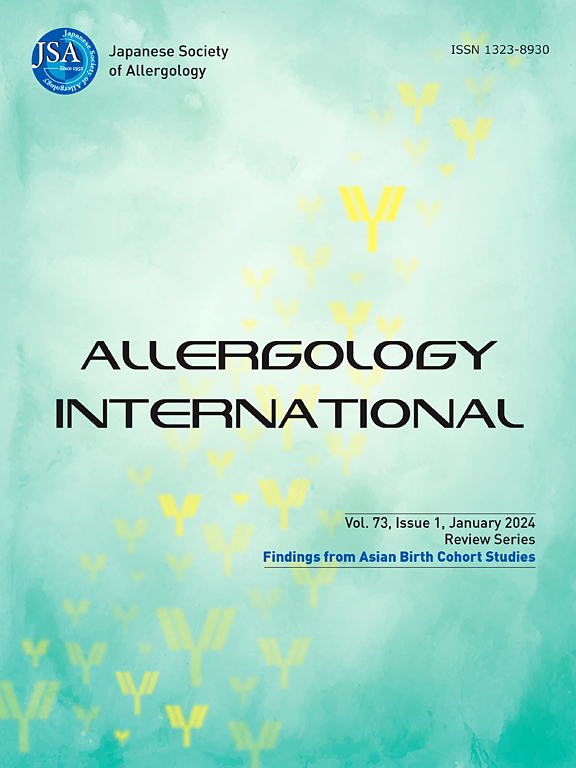Factors associated with egg aversion after a negative oral food challenge result in children with egg allergies: A multicenter questionnaire survey in Japan
IF 6.7
2区 医学
Q1 ALLERGY
引用次数: 0
Abstract
Background
Many children with egg allergies experience aversion, which hinders reintroduction after a negative oral food challenge (OFC). We aimed to assess factors associated with egg aversion in children after negative egg OFCs.
Methods
We conducted a multicenter questionnaire survey between January and December 2018 and retrospectively collected background data from the medical records. Children aged 3–18 years with a history of an immediate reaction to eggs more than 6 months after a negative OFC to half of a heated whole egg were included. We defined “aversion” as a dislike of eating eggs or processed egg products.
Results
We included 140 children (median age: 6.7 years) who passed OFCs at the median age of 3.3 years and had a median specific-IgE (sIgE) to egg white of 10.0 kUA/L. Overall, 57 (41 %) children had an egg aversion. “Disliking the food texture or taste” (61 %) was the most frequent reason for an aversion. The associated factor in the multivariate analysis was older age during a negative OFC (adjusted odds ratio: 1.24, 95 % confidence interval: 1.04–1.49). The aversion frequency depended on the type of cooking methods, where 68 % had an aversion to boiled egg whites, and less than 5 % had an aversion to egg-containing deep-fried chicken.
Conclusions
About half of the children after negative OFC had an egg aversion, and it was associated with older age during negative OFC. Careful follow-up and guidance with consideration of less aversive cooking methods are important in older age groups.
在日本进行的一项多中心问卷调查显示,在负面的口腔食物挑战后,与鸡蛋厌恶相关的因素导致了儿童鸡蛋过敏。
背景:许多有鸡蛋过敏的儿童经历厌恶,这阻碍了口服食物挑战(OFC)后的重新引入。我们的目的是评估卵子OFCs阴性后儿童厌恶鸡蛋的相关因素。方法:于2018年1月至12月进行多中心问卷调查,回顾性收集病历背景资料。研究对象为3-18岁的儿童,在对半个加热的全蛋的OFC呈阴性反应超过6个月后,对鸡蛋有立即反应史。我们将“厌恶”定义为不喜欢吃鸡蛋或加工过的蛋制品。结果:我们纳入了140名儿童(中位年龄:6.7岁),他们在中位年龄3.3岁时通过OFCs,中位蛋白特异性ige (sIgE)为10.0 kUA/L。总体而言,57名(41%)儿童厌恶鸡蛋。“不喜欢食物的质地或味道”(61%)是最常见的厌恶原因。多变量分析中的相关因素是OFC阴性时的年龄较大(校正优势比:1.24,95%可信区间:1.04-1.49)。厌恶的频率取决于烹饪方法的类型,其中68%的人讨厌煮蛋清,不到5%的人讨厌含鸡蛋的炸鸡。结论:OFC阴性后约有一半的儿童厌恶鸡蛋,并且与OFC阴性期间的年龄有关。仔细的后续行动和指导,考虑较少令人厌恶的烹饪方法,对老年群体很重要。
本文章由计算机程序翻译,如有差异,请以英文原文为准。
求助全文
约1分钟内获得全文
求助全文
来源期刊

Allergology International
ALLERGY-IMMUNOLOGY
CiteScore
12.60
自引率
5.90%
发文量
96
审稿时长
29 weeks
期刊介绍:
Allergology International is the official journal of the Japanese Society of Allergology and publishes original papers dealing with the etiology, diagnosis and treatment of allergic and related diseases. Papers may include the study of methods of controlling allergic reactions, human and animal models of hypersensitivity and other aspects of basic and applied clinical allergy in its broadest sense.
The Journal aims to encourage the international exchange of results and encourages authors from all countries to submit papers in the following three categories: Original Articles, Review Articles, and Letters to the Editor.
 求助内容:
求助内容: 应助结果提醒方式:
应助结果提醒方式:


